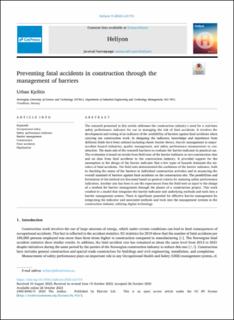| dc.contributor.author | Kjellén, Urban Anders Gunnar | |
| dc.date.accessioned | 2024-02-12T11:28:30Z | |
| dc.date.available | 2024-02-12T11:28:30Z | |
| dc.date.created | 2023-10-31T12:39:13Z | |
| dc.date.issued | 2023 | |
| dc.identifier.issn | 2405-8440 | |
| dc.identifier.uri | https://hdl.handle.net/11250/3116905 | |
| dc.description.abstract | The research presented in this article addresses the construction industry's need for a real-time safety performance indicator for use in managing the risk of fatal accidents. It involves the development and testing of an indicator of the availability of barriers against fatal accidents when carrying out construction work. In designing the indicator, knowledge and experience from different fields have been utilized including classic barrier theory, barrier management in major-accident hazard industries, quality management, and safety performance measurement in construction. The main aim of the research has been to evaluate the barrier indicator in practical use. The evaluation is based on results from field tests of the barrier indicator at two construction sites and on data from fatal accidents in the construction industry. It provided support for the assumption in the design of the barrier indicator that a few types of hazards dominate the statistics of fatal accidents. The field tests demonstrated the usefulness of the barrier indicator, both in checking the status of the barriers in individual construction activities and in measuring the overall standard of barriers against fatal accidents on the construction site. The possibilities and limitations of the method are discussed based on general criteria for assessing safety performance indicators. Another aim has been to use the experiences from the field tests as input to the design of a method for barrier management through the phases of a construction project. This work resulted in a model that integrates the barrier indicator and underlying methods and tools into a barrier management system. There is significant potential for effective barrier management by integrating the indicator and associated methods and tools into the management systems in the construction industry utilizing digital technology. | en_US |
| dc.language.iso | eng | en_US |
| dc.publisher | Elsevier | en_US |
| dc.rights | Navngivelse 4.0 Internasjonal | * |
| dc.rights.uri | http://creativecommons.org/licenses/by/4.0/deed.no | * |
| dc.title | Preventing fatal accidents in construction through the management of barriers | en_US |
| dc.title.alternative | Preventing fatal accidents in construction through the management of barriers | en_US |
| dc.type | Peer reviewed | en_US |
| dc.type | Journal article | en_US |
| dc.description.version | publishedVersion | en_US |
| dc.source.volume | 9 | en_US |
| dc.source.journal | Heliyon | en_US |
| dc.source.issue | 11 | en_US |
| dc.identifier.doi | 10.1016/j.heliyon.2023.e21715 | |
| dc.identifier.cristin | 2190485 | |
| cristin.ispublished | true | |
| cristin.fulltext | original | |
| cristin.qualitycode | 1 | |

